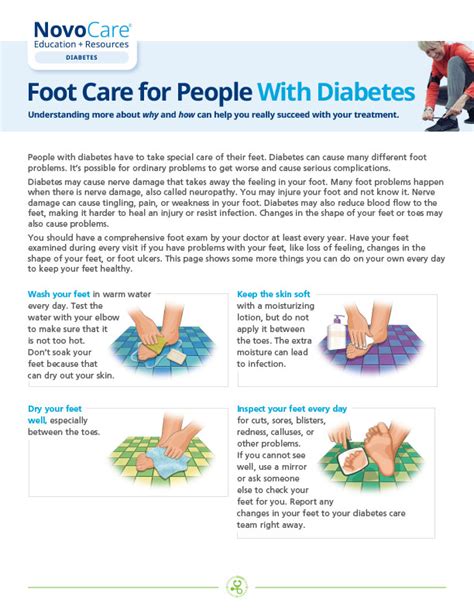Intro
Diabetic foot care is a crucial aspect of managing diabetes, as high blood sugar levels can damage nerves and lead to poor blood circulation, making it difficult for the body to heal wounds. This can lead to severe complications, including foot ulcers, infections, and even amputations. However, with proper care and attention, individuals with diabetes can prevent these complications and maintain healthy, happy feet. In this article, we will explore the importance of diabetic foot care and provide valuable tips for managing and preventing foot-related issues.
Diabetes is a chronic condition that affects millions of people worldwide, and foot care is an essential part of managing the disease. When blood sugar levels are high, it can damage the nerves and blood vessels in the feet, leading to a loss of sensation and poor circulation. This can make it difficult to feel pain or discomfort, making it easier to ignore minor issues that can quickly become major problems. Furthermore, poor circulation can slow down the healing process, making it more challenging to recover from injuries or infections. By prioritizing diabetic foot care, individuals with diabetes can reduce their risk of developing foot-related complications and maintain their overall health and well-being.
Effective diabetic foot care requires a combination of self-care practices, regular check-ups with a healthcare provider, and a proactive approach to managing blood sugar levels. By taking control of their foot health, individuals with diabetes can prevent complications, reduce their risk of infection, and maintain their mobility and independence. In the following sections, we will delve into the world of diabetic foot care, exploring the benefits, working mechanisms, and practical tips for managing and preventing foot-related issues.
Understanding Diabetic Foot Care

Benefits of Diabetic Foot Care
The benefits of diabetic foot care are numerous, ranging from preventing complications to maintaining mobility and independence. Some of the key benefits include: * Reducing the risk of foot-related complications, such as foot ulcers and infections * Maintaining good foot hygiene and preventing fungal and bacterial infections * Improving circulation and reducing the risk of poor wound healing * Preventing amputations and maintaining mobility and independence * Reducing the risk of falls and injuries by maintaining good foot health5 Diabetic Foot Care Tips

Working Mechanisms of Diabetic Foot Care
Diabetic foot care works by addressing the underlying causes of foot-related complications, such as poor circulation, nerve damage, and high blood sugar levels. By managing blood sugar levels, maintaining good foot hygiene, and wearing proper footwear, individuals with diabetes can reduce their risk of developing foot-related complications. Regular check-ups with a healthcare provider can also help identify potential issues early on, allowing for prompt treatment and prevention of complications.Practical Examples and Statistical Data

Steps for Managing Diabetic Foot Care
Managing diabetic foot care requires a proactive approach, involving regular self-care practices, check-ups with a healthcare provider, and a commitment to maintaining good foot health. Here are some steps for managing diabetic foot care: * Monitor blood sugar levels regularly * Practice good foot hygiene, including washing and drying feet daily * Wear proper footwear, including shoes that fit properly and provide adequate support * Inspect feet daily for any changes or abnormalities * Seek professional care regularly, including check-ups with a healthcare provider and foot examsCommon Foot-Related Issues in Diabetes

Prevention and Management of Foot-Related Issues
Preventing and managing foot-related issues requires a proactive approach, involving regular self-care practices, check-ups with a healthcare provider, and a commitment to maintaining good foot health. Here are some tips for preventing and managing foot-related issues: * Monitor blood sugar levels regularly * Practice good foot hygiene, including washing and drying feet daily * Wear proper footwear, including shoes that fit properly and provide adequate support * Inspect feet daily for any changes or abnormalities * Seek professional care regularly, including check-ups with a healthcare provider and foot examsConclusion and Final Thoughts

We invite you to share your thoughts and experiences with diabetic foot care in the comments below. Have you or a loved one struggled with foot-related issues due to diabetes? What steps have you taken to manage and prevent complications? Share your story and help others understand the importance of diabetic foot care.
What is diabetic foot care?
+Diabetic foot care is a comprehensive approach to managing foot health, encompassing self-care practices, regular check-ups, and a proactive approach to managing blood sugar levels.
Why is diabetic foot care important?
+Diabetic foot care is important because it can help prevent foot-related complications, such as foot ulcers, infections, and amputations, and maintain mobility and independence.
What are some common foot-related issues in diabetes?
+Common foot-related issues in diabetes include foot ulcers, infections, poor wound healing, and amputations.
How can I prevent foot-related issues in diabetes?
+You can prevent foot-related issues in diabetes by monitoring blood sugar levels, practicing good foot hygiene, wearing proper footwear, inspecting feet daily, and seeking professional care regularly.
What should I do if I notice any changes or abnormalities in my feet?
+If you notice any changes or abnormalities in your feet, you should seek professional care immediately, as prompt treatment can help prevent serious complications.
